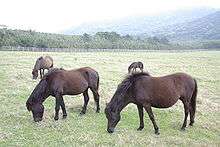Tokara pony

The Tokara pony (吐噶喇馬 Tokara-uma) (also known as the Kagoshima pony) is a Japanese pony native to the Tokara Islands, a group of islands in Kagoshima Prefecture at the southwestern tip of the island of Kyushu. Its height is about 100 to 120 centimetres (39 to 47 in) (9.3 – 11.3 hands high), or larger than a Shetland pony. Its coat color is predominantly seal brown. The Tokara has a good tolerance for heat and is used for agriculture, riding and sugar cane processing.
History
In 1952 the ponies were discovered on Takarajima by Shigeyuki Hayashida, a professor of Kagoshima University, and designated the Tokara Pony. It was theorized that the ponies were brought to Takarajima from Kikaijima around 1900. In 1953, the Tokara pony was designated a natural monument of Kagoshima. When Professor Hayashida first discovered the ponies, he counted 43. Their numbers gradually declined during the 1960s because of agricultural mechanization, however, and it was difficult to monitor the population on Takarajima. Therefore, some of the ponies were transferred to the Mt. Kaimon Natural Park and Iriki Farm, part of the agricultural department of Kagoshima University.
Endangered population
By 1974, there was only a single Tokara pony remaining on the Tokara Islands. This pony was transferred to Nakanoshima on the Tokaras, and was bred with Tokara ponies which were reintroduced from the mainland. Currently, about ten Tokara ponies are kept at Nakanoshima. A breeding farm is located at Takao, at the center of one of the islands. The pony population at Nakanoshima and on the mainland is increasing, and there is currently a total of 107 Tokara ponies. Tokara-Penn’s three mares are on display at the Hirakawa Zoo in Kagoshima. Due to its small stature,[1] the Tokara pony is no longer in demand as a plow horse on the Tokaras or the mainland and has limited utility as a riding horse; therefore, finding a practical use for the Tokara pony is a problem which will affect its future protection.
References
- ↑ Japanese native horses. International Museum of the Horse. Retrieved January 3, 2011.
.jpg)